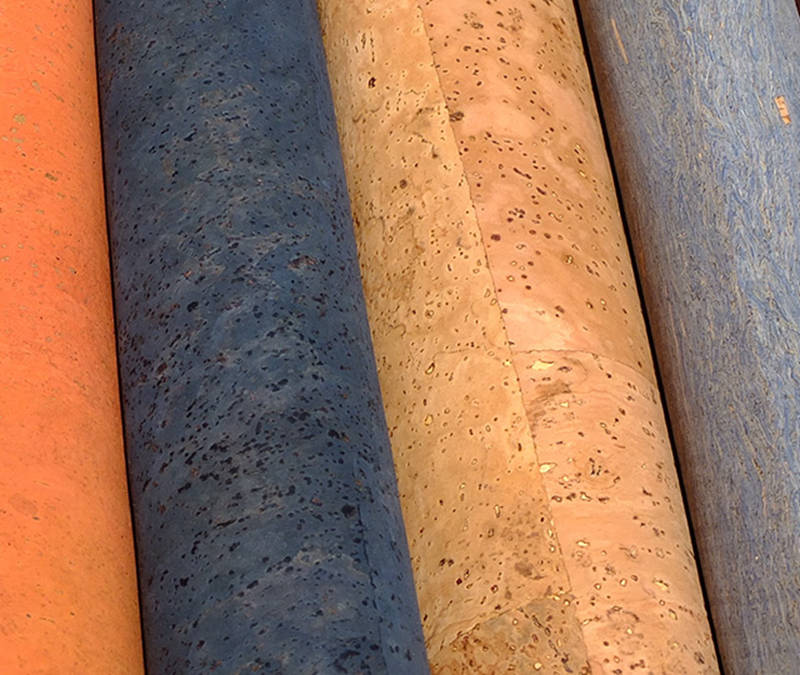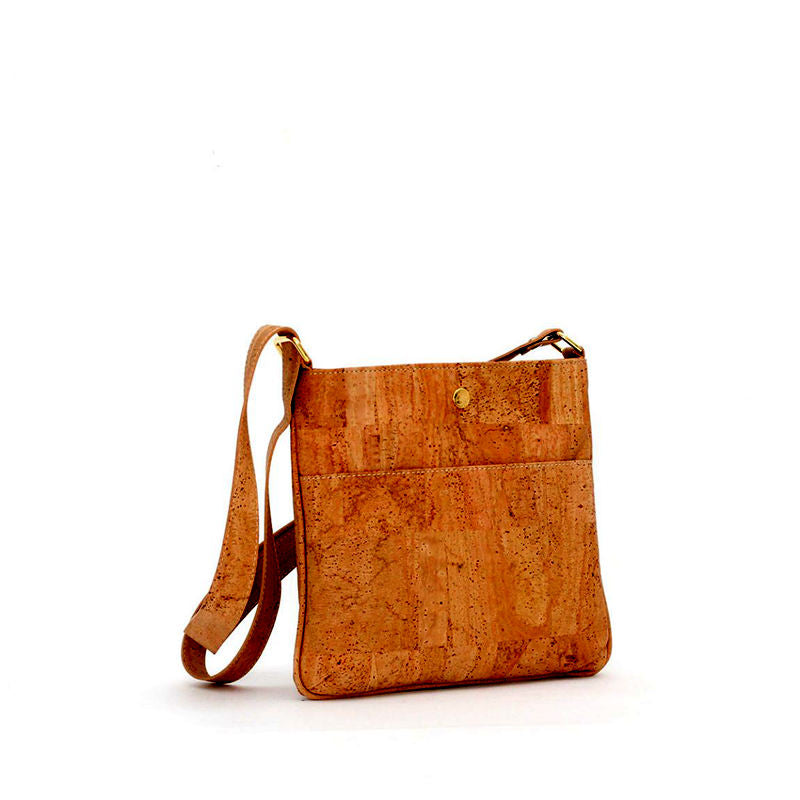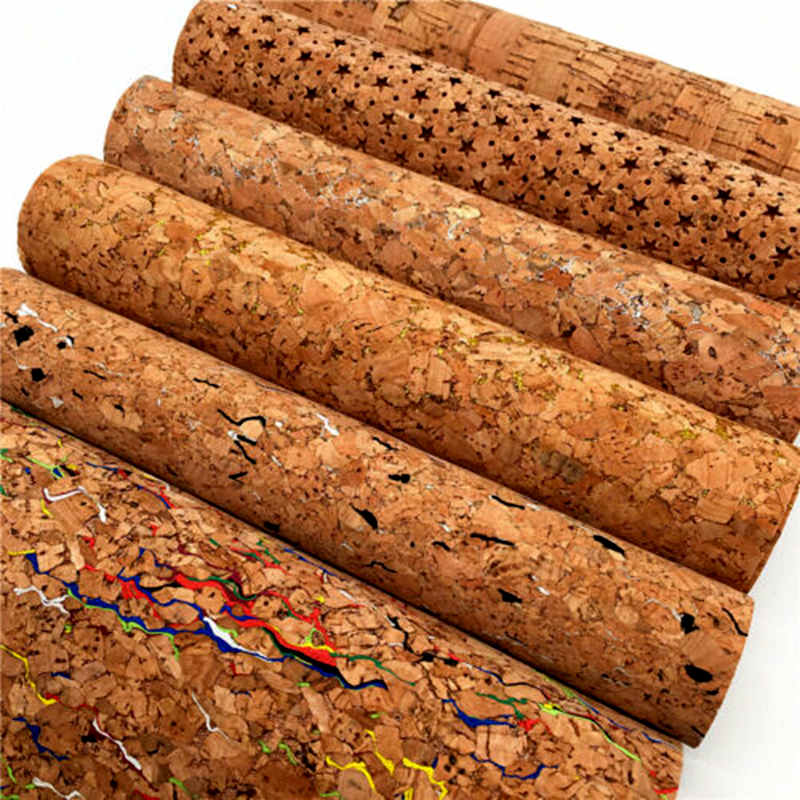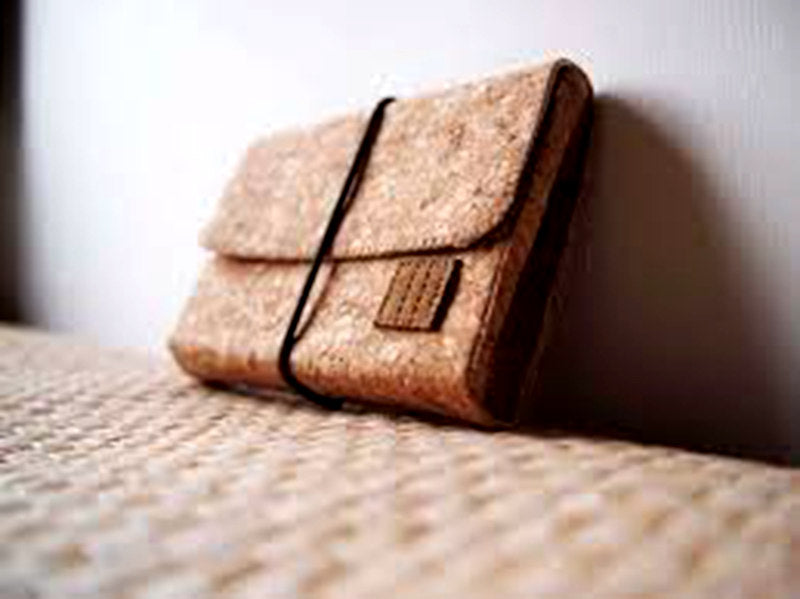Your cart is currently empty
What Is Cork Leather?
In comparison to other leathers, cork leather has a unique quality. Among the most stunning textiles available is one made from natural cork. It's harvested from the bark of cork oak trees native to warm, moist regions like the Mediterranean.
Cork oaks have a lifespan of up to 300 years and undergo a regenerative process in which their bark completely replaces itself every nine years.
As a result of this, cork is a sustainable material, and it is enjoying rising demand in the apparel sector. In this piece, we'll understand what is cork leather and talk about the good and bad points of using it.
Following our advice, you can expect your cork cloth purchases to last for years. Read on to find out more about this one-of-a-kind content!

What is Cork leather?
Genuine leather has no equal when it comes to looking good. Its inherent grace and opulence are unmatched by any synthetic material. But suppose you could imitate leather's properties without actually using animal skins. Because now you can make use of cork leather in this regard.
Cork leather is a renewable material derived from the tree's bark, it's a popular alternative to traditional leather. The Mediterranean cork oak tree has been harvested for generations for its useful corks, which have been used in everything from wine stoppers to flooring. Each harvest takes place every nine to ten years and causes no harm to the tree.
Cork leather is versatile since it lasts long, is good for the environment, and looks great in any setting. Compared to conventional leather, cork leather is a more eco-friendly and long-lasting option. It's great for a backpack and other uses because it repels water and has a distinctive gritty texture.
Leather made from cork is an eco-friendly and fashionable option. Its earthy feel and one-of-a-kind hue make it perfect for the fashion-forward person who wants to do their part for the environment without sacrificing style.
It is the ideal material for outerwear, accessories, and more because it is long-lasting and adaptable. If you're looking for a green alternative to synthetic materials, thin cork shavings are a great choice.

This cutting-edge new fabric is eco-friendly because it's crafted from cork trees that don't deplete natural resources. Furthermore, these items will maintain their temperature all year round because of the cork's insulating properties. In addition, cork's one-of-a-kind grain gives each item a unique appearance.
Cork leather: a brief history
Wine stoppers, floors, and other things have all been crafted from cork leather for generations. The Mediterranean cork oak tree has been harvested for generations for its useful corks, which have been used in everything from wine stoppers to flooring. Cork leather is versatile since it lasts long, is good for the environment, and looks great in any setting.
Cork has been used for centuries; the ancient Greeks and Romans even used it for rafts and shoes. Pins were used to creating wax seals for documents and candles in the 17th century. In the 19th century, the cork tree's use as an insulator and soundproofing material gained widespread attention. And it was also utilized to create flotation devices and life vests.
Soles for shoes were the earliest known application of cork leather, which dates back to 1855. The use of cork leather for footwear, purses, and other accessories skyrocketed in the early 20th century. Its popularity waned after WWII, but it has seen a recent upswing.
Is cork leather real leather?
Sustainable and eco-friendly, cork leather is tanned from the cork oak tree's bark. High durability and a distinctive appearance make this fabric exceptional. It's an excellent substitute for animal leather because it's durable, easy to clean, and won't scratch or stain.
Bags, shoes, belts, etc. manufactured from genuine leather have been used for generations. While nothing can replace the feel of genuine leather, synthetic materials like cork and polyurethane (PU) leather are increasingly popular in the fashion industry because of their low prices and quick production times. To bridge the gap between consumer demand for leather goods and the prohibitively high cost of real leather, numerous textile companies have begun dealing in cork leather.

What material is cork made of?
Cork comes from the phellem layer of the oak tree and is a natural, durable substance. Suberin, a naturally occurring elastic and impermeable plant component, gives cork its water-resistant properties. Cork is often composed of complex plant polymers like suberin, lignin, and cellulose, though this can vary greatly depending on the cork tree's origin and growing conditions. Both plant and wood fiber primarily consist of cellulose and lignin.
When an oak tree reaches the age of 25, it is ready to be harvested by a manufacturing company. The cork is harvested by simply peeling back the bark. The production process is eco-friendly, and the end product can be reused or recycled.
What is cork leather used for?
Cork is a natural substance that has been utilized for thousands of years in a wide variety of everyday contexts, including but not limited to floatation devices and beverage stoppers. Cork is not only a time-honored and versatile material but also a completely sustainable and recyclable one. There are various uses for cork cloth, and it may be safely used indoors and out.
As well as being used for packing and insulation, cork leather fabric is frequently seen in various other products, such as bags, luggage, wallets, apparel, and accessories. Gaskets, floor and wall ties, fishing gear, wine bottling, decorative products, and more all use cork in their production. Creative and eco-friendly clothing, shoes, and accessories result from designers' usage of cork leather fabric. Fabrics, furniture, and packaging for the home, as well as building materials for businesses, are all possible thanks to the versatility of cork.

Why is cork a good material?
Cork has excellent durability, flexibility, and water resistance. It's a durable and sustainable option. It's a highly flexible textile that may be used in various contexts.
The versatility of cork as a building material and decorative element is unmatched. It's a fantastic textile for apparel, footwear, and accessories due to its high quality and wide range of valuable properties.
You can carry around a lot of cork without ever becoming tired of its soft, lightweight, and long-lasting comfort. In addition to being eco-friendly, recyclable, and biodegradable, it is made entirely from natural materials.
Cork is gaining in popularity. Increasingly, consumers are looking to businesses and designers who can provide environmentally friendly, ethical, and reasonably priced options, and cork helps fashion firms and designers do just that.
The future of the fashion industry is dependent on the cork. It helps bolster efforts to create a local economy that is both sustainable and socially conscious. One way cork may support the growth of the ethical fashion sector is by strengthening the supply chain.
Is cork leather washable?
Cork leather differs from traditional leather in that it can become wet and be washed in a washing machine with hot water. Eco-friendly, hypoallergenic, durable, and resistant to moisture and stains, cork leather fabric is an excellent choice for any project.
To remove the black markings of the cork surface, dip a small hand towel or cleaning cloth into warm water (combined with a tiny amount of soap). The same effect can be achieved with baby wipes or alcohol wipes to clean your baggage.

How do you maintain cork leather?
The cork you used in your purchases is a naturally waterproof material. There is no need to clean. Warm water and a gentle cleaning cloth will do the trick. It's more than enough.
Add a few drops of detergent to a soft, damp cloth if you still have trouble. Then put it to use, cleaning the leather.
Avoid using any drying heat and instead, let the case air dry. Products made from cork require less effort to clean than those made from other materials such as leather, fabric, etc.
Don't drown your clothes in detergent; just a few drops will do. In addition, please follow the guidelines provided below.
- Do Not Wash
- Do Not Use Bleach
- Not Tightening
- Do Not Dry Cleaning
- Not doing the ironing.
Why Cork Leather
When people hear the word "cork," their minds may immediately go to cork boards or wine stoppers, but rarely to cork as a fabric. The use of cork material, or "Cork Leather" as it is more commonly known, is becoming increasingly common.
- Ecologically Friendly -
Cork is a sustainable resource because it is extracted from the tree bark of the Cork Oak. Cork Oaks are unique because they can regrow their bark every 9–10 years, making them safe to harvest without damaging the tree.
The cork is extracted by hand by farmers by cutting and peeling the bark. It can extend its existence by up to 12 years by regrowing its bark. To remove non-productive cork oak trees, farmers must apply for and receive specific approval from a government agency.
- Water Resistant -
With this property in mind, it is clear why corks are employed to seal wine bottles. It prevents gases and liquids from penetrating, so your smartwatch is the only electronic device you need to protect from water damage.
- Durable -
Due to its honeycomb structure, cork is highly resilient to damage and wear.
- Fire Resistant –
Because of its fire retardant properties, it burns without a flame and produces no harmful byproducts during combustion.
- Extremely Light -
Since half of a cork's volume is air, its density is only.16 g/cm3. Because of its low density, it can be floated on the water.
- Hypoallergenic -
This is an excellent option for people suffering from asthma or allergies because it does not trap dust.
A lovely and long-lasting item, thanks to its lightweight and airy construction and resistance to wear and water.
Is cork an excellent alternative to leather?
You need not look much farther if you are in search of an exciting substitute for leather that is both robust and watertight. In recent years, cork's star has risen rapidly as a trendy new fabric choice.
In addition to being resistant to water, renewable, and recyclable, cork is long-lasting, lightweight, and simple to maintain.
Cork is an all-natural material harvested from cork oak trees. Cork oak trees have a lifespan of about 300 years, and though their bark is stripped every decade, the trees keep growing and producing new cork. Wearing cork helps keep the cork oak woods, home to many threatened species, from being depleted by desertification.
A few benefits of Cork leather
The advantages are outlined below.
- Despite being a novel material, it has quickly gained appeal due to its many benefits.
- As a renewable and non-depletable resource, it has the benefit of being environmentally benign. Typical of the Mediterranean region, the cork oak tree can live for up to two centuries.
- Removing the tree's bark every 9-12 years is OK.
- Furthermore, it is tough as nails and resistant to wear and strain. As a bonus, it is weather resistant, making it an excellent material for footwear and outdoor furniture.
- People with sensitivities or allergies can benefit from its hypoallergenic and antibacterial properties.
- Cork leather has the added benefits of being both lightweight and soft to the touch.
- Its distinctive grain pattern is one of its most attractive features.
Flaws in Cork-based leather
Let's go into the specific drawbacks right away!
- The cost of production is higher than for conventional leather. Compared to regular leather, it won't last as long. Locating cork leather goods might be arduous.
- Not as long-lasting as regular leather, and cork leather goods can be hard to come by.
- It may not be as soft to the touch as genuine leather and may not hold up as well over time.
- It’s not as tough as genuine leather, so it might not be the best choice for things that get a lot of use.
- Cork leather might be more challenging to work with than conventional leather due to its thinner and more malleable nature.
Is cork a sustainable material?
By definition, all cork goods are all-natural. Traditionally, the fibers used to create cork textiles have been extracted from oak trees. Contrarily, cork leather fabrics are made with a thin cork layer adhered to a woven backing fabric.
The most eco-friendly fabrics to use as backing are those made from organic cotton, linen, or hemp. When shopping for cork products, it is essential to check the textile backing and avoid synthetic textiles if possible.
Products made from cork have many positive effects on natural and built environments. They provide a source of income for local artisans and weavers.
It's common knowledge that items made from cork have a smaller ecological footprint. Weaving and processing cork solely employs organic materials. Fabrics and clothing made from cork are sustainable and kind to the environment. In addition to being recyclable and compostable, it is also completely biodegradable.
In contrast to cotton, the cork oak tree can flourish without chemical fertilizers or pesticides. Furthermore, cork does not shed microfibers, a significant marine, and riverine pollution source. Cork doesn't release any harmful chemicals when burned, either. They produce no toxic byproducts and cause no waste.
When it comes to helping the environment, few other natural fibers can compare to cork. It's important to know where the cork came from in the first place before buying anything made with the stuff. Support small businesses that care about the environment and responsibly conduct their operations by purchasing their products.
Repercussions of using Cork leather
In comparison to synthetic materials, cork's natural benefits are numerous. It's sustainable, long-lasting, and has a one-of-a-kind look that can elevate any endeavor. As with many other materials, cork has many uses. Flooring, furniture, clothing, and other fantastic cork leather accessories are all possible applications.
Repercussions of using cork leather on human and animal health
Cork material, often known as cork leather, is crafted from the tree bark in cork oak forests. This leather is produced in a manner analogous to conventional leather, except that the bark of the cork tree is used in place of animal skin.
In addition to being eco-friendlier, more long-lasting, and less likely to cause allergic reactions, it also has several other advantages over conventional leather. It is much more durable and stain-resistant than animal leather using thin cork sheets.
These fascinating materials have many uses for both humans and animals. Cork bark is a sustainable food source for animals that won't harm trees.
Cork leather's detrimental effects on the environment
Numerous explanations exist. For starters, it has long-term viability and is gentle on the planet. You may buy with confidence, knowing that your cork comes from cork oak trees that have not been harmed in the process.
It's one of the most eco-friendly building blocks on the market today. As the bark of cork trees regrows rapidly after being harvested every nine years, cork is a renewable resource. It may be recycled and decomposes naturally.
Cork leather has many advantages, including the fact that it is eco-friendly. This is an excellent option for those looking for a sustainable material without sacrificing style or originality.
So, why go for cork leather...
Because of its strength, durability, and good looks, it makes a great accessory or piece of furniture. One thing to remember is that cork leather is also good for the planet. This is because cork harvesting does not harm the tree, and cork may be picked again because new bark grows each time. Cork leather is both fashionable and environmentally friendly, making it an excellent option.
Shop our collection of:
Leather Backpacks | Men's Leather Bags | Women's Leather Bags | Custom Leather Journals | Handmade Leather Messenger Bags
Related Blog Posts:




